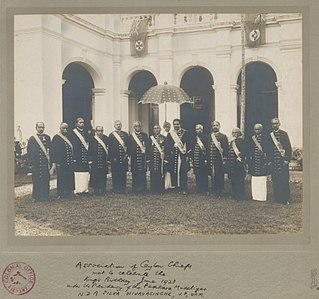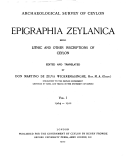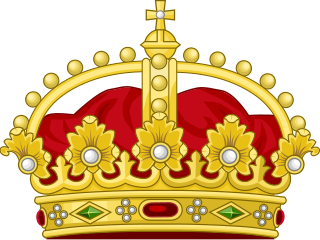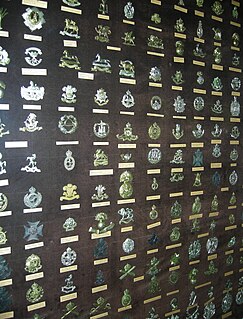Mukkuvar is a caste found in the coastal regions of Sri Lanka and the Indian states of Tamil Nadu and Kerala.

Ketheeswaram temple is an ancient Hindu temple in Mannar, Northern Province Sri Lanka. Overlooking the ancient period Tamil port towns of Manthai and Kudiramalai, the temple has lay in ruins, been restored, renovated and enlarged by various royals and devotees throughout its history. Tirukkētīsvaram is one of the Pancha Ishwarams dedicated to the Hindu deity Shiva and is venerated by Shaivas throughout the continent. Throughout its history, the temple has been administered and frequented by Sri Lankan Hindu Tamils. Its famous tank, the Palavi tank, is of ancient antiquity and was restored from the ruins. Tirukkētīsvaram is one of the 275 Paadal Petra Sthalams of Shiva glorified in the poems of the Tevaram.

Karava also Karave, Kara and Kaurawa is a Sinhalese caste from Sri Lanka. The Tamil equivalent is Karaiyar. They are traditionally coastal people occupied in seafaring, fishing and naval warfare.

Mudali was a colonial title and office in Ceylon. The Portuguese colonials created the Mudaliyar class in the 17th century by enlisting natives of different castes from the coastal areas.

Sir Don Baron Jayatilaka known as D.B. Jayatilaka was a Sri Lankan educationalist, statesmen and diplomat. He was Vice-President of the Legislative Council of Ceylon; the Minister for Home Affairs and Leader of the House of the State Council of Ceylon; and Representative of Government of Ceylon in New Delhi. Sir D. B. Jayatilaka is also considered as a flag bearer of Buddhist education in Sri Lanka.
Paulus Edward Pieris Deraniyagala (1900–1976) was Sri Lankan paleontologist, zoologist, and artist.

Udugampola is a small town in the Gampaha District of Sri Lanka and was a sub kingdom during reign of the King Sakala Kala Wallabha of Kotte Era. The main point in the area is around the intersection of Gampaha-Minuwangoda and Kotugoda-Naiwala roads.
The Royal Asiatic Society of Sri Lanka (RASSL) is based in Colombo, Sri Lanka. It is one of the oldest learned societies in Sri Lanka with a history of over 160 years. It was established on 7 February 1845, paralleling the Royal Asiatic Society of Great Britain and Ireland to further oriental research as the Ceylon Branch of the Royal Asiatic Society. In 1977 it was renamed the Royal Asiatic Society of Sri Lanka.

The National Museum of Kandy in Kandy, Sri Lanka is located next to the Temple of the Tooth in part of the former Royal Palace of Kandy. The primary exhibits are housed in the Palle Vahala building, which was the former home of the King's harem. A secondary exhibition is located in the main palace building. The museum is maintained by the Department of National Museums.
Dr Christopher Gunapala Uragoda MBBS (Ceylon), MD (Ceylon), Hon. DSc (Colombo), FRCP (Edin), FRCP (Glasg), also known as Chris Uragoda, is a Sri Lankan physician, author, folklorist, historian and conservationist

Deshamanya Justice Henry Wijeyakone Thambiah (1906–1997) was a Ceylonese academic, diplomat, lawyer and judge, born in Sri Lanka during British colonial rule. He was a Commissioner of Assize, High Commissioner and judge of the Supreme Courts of Ceylon and Sierra Leone.

Epigraphia Zeylanica is an irregularly published series that deals with epigraphs and other records from ancient Ceylon. Established in 1904, the series' contents range from individual articles and notes on inscriptions to single-author monographs. Over the last century, Epigraphia Zeylanica has functioned as a key source for the history of ancient Ceylon and its early epigraphic records.

Alamat Lankapuri was a Malay language fortnightly publication in Jawi script, issued from Colombo, Ceylon. Alamat Lankapuri was first published in June 1869. It was the first Jawi script Malay-language newspaper printed worldwide. The newspaper was printed by lithograph.
John Stark was a Scottish lawyer who became the ninth Queen's Advocate of Ceylon.
The Doric Bungalow at Arippu East, Mannar, Sri Lanka, was the residence of the first British Governor of Ceylon.
Doctor Charles Edmund Godakumbura was the Commissioner of Archaeology in Ceylon from 1956 to 1967.
The Right Reverend Edmund Pieris, O.M.I. was a Roman Catholic Bishop of Chilaw, Ceylon.

Simon Casie Chetty was a Ceylonese civil servant, author and member of the Legislative Council of Ceylon.
Manikku Badaturu Ariyapala was a Sri Lankan academic and former President of the Colombo Campus, University of Colombo.
Alli Rani, also known as Alli Arasani, is a legendary Tamil queen of the Sangam period, who is thought to have ruled the whole western and northern coast of Sri Lanka from her capital Kudiramalai. According to folklore, her fort, Allirani fort, is located in Mannar, Sri Lanka. She is sometimes seen as an incarnation or multiform of Meenakshi and Kannagi. Legends attribute her as an "Amazon" ruler, who had an administrative and an army of only women, with male being their subordinates and servants.












